UPSC DAILY CURRENT AFFAIRS (7TH SEPTEMBER, 2024)
India Middle-East Europe Economic Corridor to Boost Maritime Security
Syllabus: GS3/International Relations
Context
- The Union Minister of Commerce & Industry stated that the India-Middle East-Europe Economic Corridor (IMEC) can add to India’s maritime security and faster movement of goods between Europe and Asia.
India-Middle East-Europe Economic Corridor (IMEC)
- Participants: During the Delhi G20 Summit, India, USA, UAE, Saudi Arabia, France, Germany, Italy and the European Union signed a Memorandum of Understanding (MoU) to establish the India-Middle East-Europe Economic Corridor.
- Objective: The corridor will encourage and provide impetus to economic development through enhanced connectivity and economic integration between Asia, West Asia, the Middle East and Europe.
Components
- The India-Middle East-Europe Economic Corridor will consist of two separate corridors,
- The East corridor connecting India to West Asia/Middle East and
- The Northern corridor connecting West Asia/Middle East to Europe.
- The project would involve the building of a railway line across the Arabian Peninsula through the United Arab Emirates and Saudi Arabia and develop shipping connectivity to India and Europe on either end of this corridor.
- The corridor could be further developed to transport energy through pipelines and data through an optical fiber link.
Ports Which are Part of IMEC
- India: Ports in Mundra (Gujarat), Kandla (Gujarat), and Jawaharlal Nehru Port Trust (Navi Mumbai).
- Europe: Piraeus in Greece, Messina in Southern Italy, and Marseille in France.
- Middle East: Ports include Fujairah, Jebel Ali, and Abu Dhabi in the UAE, as well as Dammam and Ras Al Khair ports in Saudi Arabia.
- Israel: Haifa port.
- Railway Line: The railway line will link Fujairah port in the UAE to Haifa port in Israel, passing through Saudi Arabia (Ghuwaifat and Haradh) and Jordan.
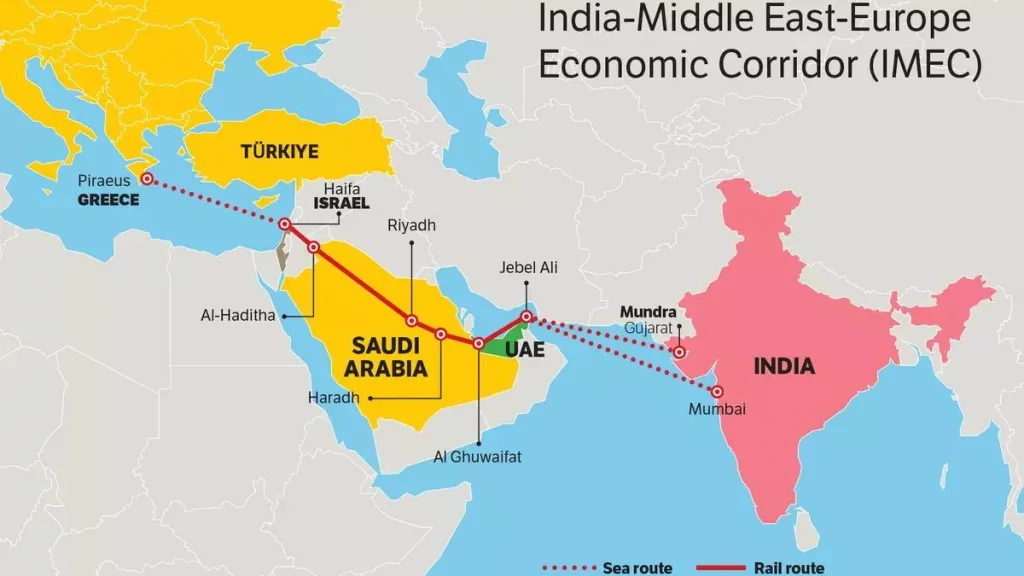
Maritime security for India
- The IMEC creates a robust and secure trade corridor across important maritime routes. It will give India a strategic role in patrolling and securing these areas
- India’s involvement ensures its critical maritime chokepoints, like the Arabian Sea and the Strait of Hormuz, are safeguarded.
- The collaboration between countries in the corridor will facilitate increased intelligence-sharing and joint maritime exercises.
- It will help India to monitor maritime threats like piracy, trafficking, and terrorism, particularly in volatile zones like the Gulf of Aden or the Red Sea.
- As IMEC improves connectivity, India has an opportunity to expand its naval presence in strategic ports within the Middle East and Eastern Mediterranean.
- This bolsters India’s power projection capability and ensures a protective watch over its trade routes.
- IMEC will ensure India that the strategic Indian Ocean region does not become dominated by Chinese investments, thereby preserving its maritime dominance and reducing external threats.
Other Opportunities for India
- Bypassing Pakistan: IMEC breaks Pakistan’s veto over India’s overland connectivity to the West. Since the 1990s, India has sought various trans-regional connectivity projects with Pakistan.
- But Pakistan was adamant in its refusal to let India gain access to land-locked Afghanistan and Central Asia.
- Indo-US collaboration in the Middle East: This project has broken the myth that India and the United States might work together in the Indo-Pacific but not in the Middle East.
Hurdle before IMEC
- The Israel-Palestine conflict has put a pause on the normalization of Arab-Israel relations which is a key element of the multi-nation initiative.
- Vulnerability of the Strait of Hormuz: The entire trade of the IMEC architecture flows through the Strait of Hormuz and with Iran’s proximity and control over the strait, the risk of disruptions remain very high.
- The security challenges in the region have made other partners reluctant to invest in the project.
Way Forward
- The geopolitical concerns need to be managed by striking a delicate balance in accommodating the geopolitical interests of the participating nations and addressing potential political sensitivities.
- There is also a need to maintain the required security apparatus as the project passes through certain unstable regions of the world.
Vishvasya-Blockchain Technology Stack
Syllabus: GS 3/S&T
In News
- The Ministry of Electronics and Information Technology (MeitY) launched the Vishvasya-Blockchain Technology Stack.
Blockchain Technology
- Blockchain is a shared, immutable ledger that records transactions and tracks assets across a business network.
- It stores information electronically in a digital format to ensure transaction security.
- It is known as Distributed Ledger Technology (DLT).
- It converts and stores anything of value, including currency, in a digital format.
- Historical linkages :It was first proposed in 1991 as a research project, but in the year 2009, Blockchain was used in bitcoin
- Bitcoin is a cryptocurrency which is built on the basis of Block technology.
- Structure and Security: Consists of interconnected data blocks.
- Each block is linked to the previous one, forming a chain.
- Blocks are designed to be secure and resistant to tampering or hacking.
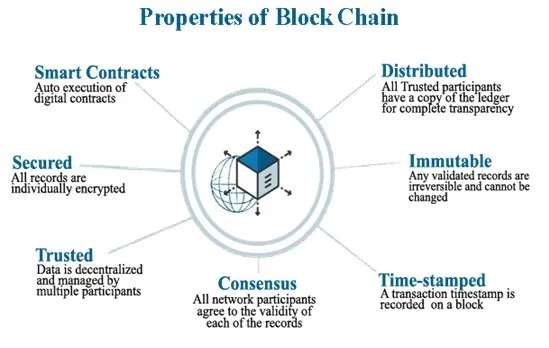
Applications
- Finance and Banking: Financial institution Testing blockchain for trade finance, foreign exchange, cross-border settlement, and securities.
- India, with its large underbanked population, can leverage blockchain for financial inclusion.
- Blockchain has been used in the creation of various cryptocurrencies, decentralized finance applications, non-fungible tokens and smart contracts.
- Governance and Public Services: Blockchain’s potential to enhance transparency and accountability in governance is being actively explored. Applications include land record management, voting systems, and identity verification.
- Healthcare: In healthcare, blockchain can be used to securely manage patient records, ensure data integrity, and facilitate the secure sharing of medical information between institutions.
- Transparent Elections: Blockchain can enhance election processes by providing transparent and tamper-proof voting records.
- Supply Chain Management:Tracking goods from origin to destination becomes more reliable using blockchain.
- India’s vast supply chains can benefit from increased transparency and traceability.
Challenges and Criticisms:
- Lack of Awareness : Despite growing interest, blockchain technology is still at a nascent stage in India.
- Many industries are yet to fully grasp its potential.
- Misconceptions persist, such as the belief that blockchain will replace existing systems entirely.
- Scalability Concerns: Scalability remains a significant challenge.
- Regulatory Uncertainty: Clear regulatory guidelines are essential for widespread adoption.
- India is making progress, but further clarity is needed.
- Cybercrime: Increased crypto adoption has led to a rise in scams and cybercrime.
- India’s nascent regulations make it difficult for victims to recover losses and for authorities to address crypto-related crimes effectively.
Recent Steps
- Vishvasya-Blockchain Technology Stack : It offers Blockchain-as-a-Service with a geographically distributed infrastructure designed to support various permissioned Blockchain based applications.
- National Blockchain Framework :MeitY, with the vision to create trusted digital platforms, initiated National Blockchain Framework (NBF) for promoting research and application development; facilitating state of the art, transparent, secure and trusted digital service delivery to citizens.
- MeitY also unveiled the NBFLite-Lightweight Blockchain Platform, Praamaanik – an innovative blockchain-enabled solution for verifying mobile app origin and National Blockchain Portal.
- Blockchain Sandbox for Startups and Academia: NBFLite, a Blockchain sandbox platform, is developed especially for startups/academia for rapid prototyping of applications, carrying out research and capacity building.
Conclusion and Way Forward
- The Blockchain technology holds immense potential for transforming governance in India by making public services more transparent, efficient, and accountable.
- It has the potential to create new industries and transform existing ones, such as facilitating nano-payments and wealth redistribution.
- As blockchain networks grow, ensuring efficient transaction processing becomes crucial.
- The stakeholders should aim to position India as a global leader in blockchain technology and proliferate the developed solutions for Global adoption, leveraging it to drive economic growth, social development, and digital empowerment.
Technical Textiles Will Cross $10 Billion by 2030
Syllabus: GS3/Economy
Context
- As per the Union Minister for Textiles, Annual export of technical textiles will cross $10 billion by 2030.
What are Technical Textiles?
- Technical textiles are defined as textile materials and products used primarily for their technical performance and functional properties rather than their aesthetic or decorative characteristics.
- They are manufactured using natural as well as man-made fibres such as that exhibit enhanced functional properties such as higher tenacity, excellent insulation, improved thermal resistance etc.
- Application: These products find end-use application across multiple non-conventional textile industries such as healthcare, construction, automobile, aerospace, sports, defence, agriculture.
- They are used individually to satisfy specific functions such as fire retardant fabric for uniforms of firemen and coated fabric to be used as awnings.
- As a component or part of another product, they are used to enhance the strength, performance or other functional properties of that product.
- Significance: Technical textiles have cost effectiveness; durability; high strength; light weight; versatility; customization; user friendliness; eco friendliness; logistical convenience etc.
Technical Textile Sector of India
- Technical textile accounts for approximately 13% of India’s total textile.
- Global trade in technical textiles is around $300 billion, while India’s domestic market size is $25 billion and annual exports are worth $2.6 billion.
- Availability of raw materials such as cotton, wood, jute and silk along with a strong value chain, low cost labour, power and changing consumer trends are some of the contributing factors to India’s growth in this sector.

Government Initiatives
- National Technical Textiles Mission (NTTM): Launched in 2020, it aims to develop a strong ecosystem for technical textiles by supporting various activities such as setting up centers of excellence, conducting R&D, and encouraging industry collaboration.
- Production Linked Incentive (PLI) Scheme: Under the PLI Scheme for textiles, the government offers incentives to companies for increasing production and achieving higher sales of technical textiles.
- Support for Innovation and R&D: The government promotes innovation in technical textiles through funding and support for research projects.
- Technotex India: It is a flagship event organised by the Ministry of Textiles, in collaboration with Federation of Indian Chambers of Commerce & Industry (FICCI) and comprises exhibitions, conferences and seminars with participation of stakeholders from across the global technical textile value chain.
India Tops Plastic Pollution Rankings
Syllabus: GS3/ Environment
Context
- According to a new study published in the journal Nature, India has secured the top spot as biggest plastic polluter in the world, releasing 9.3 million tonnes (Mt) annually.
Key highlights of the study
- The study defines plastic emissions as materials that have moved from the managed or mismanaged system (controlled or contained state) to the unmanaged system (uncontrolled or uncontained state — the environment).
- The plastic pollution from India amounts to roughly one-fifth of global plastic emissions.
- India’s waste generation rate is approximately 0.12 kilograms per capita per day.
- The global plastic waste emissions were at 52.1 Mt per year in 2020.
- While littering was the largest emission source in the Global North, uncollected waste was the dominant source across the Global South.
- The 2nd and 3rd biggest plastic polluters are Nigeria, with 3.5 million tonnes of emissions, and Indonesia, with 3.4 million tonnes.
- Furthermore, high-income countries have higher plastic waste generation rates, but most have 100 per cent collection coverage and controlled disposal, the study highlighted.
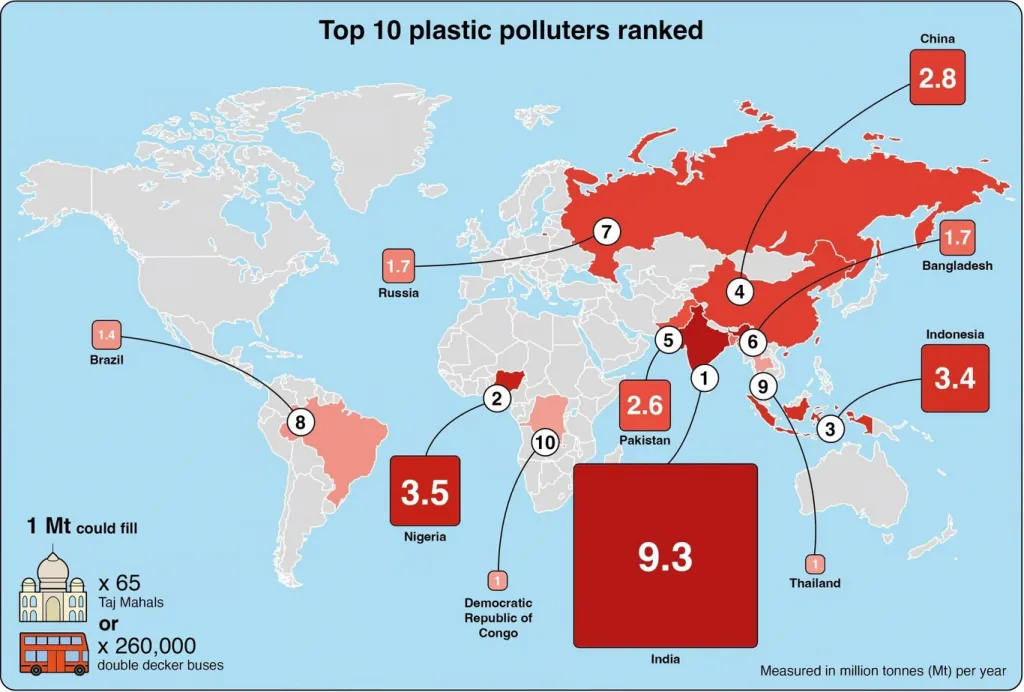
Concerns of Plastic Pollution
- Plastics are hard to eradicate due to their slow decomposition rate in natural ecosystems.
- Plastics break down into their smaller units called microplastics, which find their way across the planet, from the depths of the Pacific Ocean to the heights of the Himalayas.
- BPA or Bisphenol A, the chemical which is used to harden the plastic contaminates food and drinks, causing alterations in liver function, fetal development in pregnant women, the reproductive system and brain function.
- Plastic, which is a petroleum product, also contributes to global warming. If plastic waste is incinerated, it releases toxic fumes and carbon dioxide into the atmosphere.
- Plastic waste damages the aesthetic value of tourist destinations, leading to decreased tourism-related incomes and major economic costs related to the cleaning and maintenance of the sites.
Reasons for India’s high plastic pollution
- Inadequate waste management infrastructure: Data from 2019-20 shows that 50% of the total plastic waste in the country (34.7 lakh TPA) remained unutilised, leading it to pollute air, water and soil.
- Data gap: The Public Account Committee observed from CAG’s 2022 audit findings that many state pollution control boards (SPCBs) did not provide data on plastic waste generation for the period 2016-18 and there were inconsistencies in data shared by urban local bodies (ULBs) with SPCBs.
- Recycling inefficiencies: The existing recycling system is largely informal and unregulated, leading to low-quality recycled plastic and limited environmental benefits.
Global Efforts In Tackling Plastic Waste
- London Convention: The 1972 Convention on the Prevention of Marine Pollution by Dumping Wastes and Other Matter.
- Clean Seas Campaign: The United Nations Environment Programme launched the Campaign in 2017. It became the largest global campaign to raise awareness on plastic pollution and marine litter.
- Basel Convention: In 2019, the Basel Convention was amended to include plastic waste as a regulated material.
- The Convention contains three main entries on plastic wastes in Annex II, VIII and IX of the Convention. The Plastic Waste Amendments of the convention are now binding on 186 States.
India’s Efforts In Tackling Plastic Waste
- Extended Producer Responsibility (EPR): The Indian government has implemented EPR, making plastic manufacturers responsible for managing and disposing of the waste generated by their products.
- Plastic Waste Management (Amendment) Rules, 2022: It prohibits manufacture, import, stocking, distribution, sale and use of plastic carry bags having thickness less than 120 microns.
- Swachh Bharat Abhiyan: It is a national cleanliness campaign, which includes the collection and disposal of plastic waste.
- Plastic Parks: India has set up Plastic Parks, which are specialized industrial zones for recycling and processing plastic waste.
- Beach clean-up drives: The Indian government and various non-governmental organizations have organized beach clean-up drives to collect and dispose of plastic waste from beaches.
Way Ahead
- To tackle the challenge of plastic pollution there is a need for behavioral change and strengthening of the institutional system for the collection, segregation and recycling of plastic waste.
- Under the UN Environment Assembly Resolution 5/14, the Intergovernmental Negotiating Committee (INC) is responsible for delivering a legally binding global plastics treaty by the end of 2024.
Jal Sanchay Jan Bhagidari Initiative
Syllabus: GS3/Environmental Conservation, Water Conservation
Context
- The Prime Minister has launched the ‘Jal Sanchay Jan Bhagidari’ initiative to enhance rainwater harvesting and ensure long-term water sustainability.
About
- Under this program, approximately 24,800 rainwater harvesting structures are being constructed across the state to enhance rainwater harvesting and ensure long-term water sustainability.
- The ‘Jal Sanchay Jan Bhagidari’ initiative seeks to conserve water with a strong emphasis on community partnership and ownership.
- It is driven by a whole-of-society and a whole-of-government approach.
Rain Water Harvesting
- Rain water harvesting is the collection and storage of rain water that runs off from roof tops, parks, roads, open grounds, etc.
- This water run off can be either stored or recharged into the ground water.
- A rainwater harvesting systems consists of the following components:
- catchment from where water is captured and stored or recharged,
- conveyance system that carries the water harvested from the catchment to the storage/recharge zone,
- first flush that is used to flush out the first spell of rain,
- filter used to remove pollutants,
- storage tanks and/or various recharge structures.
Significance
- Water Conservation: Collecting rainwater reduces the demand on local water supplies, which can help conserve freshwater resources.
- Reduced Stormwater Runoff: Harvesting rainwater helps reduce the volume of runoff, which can decrease soil erosion and reduce the risk of flooding.
- This also helps minimize the impact on local waterways and ecosystems.
- Groundwater Recharge: Some systems are designed to allow harvested rainwater to seep back into the ground, helping to recharge groundwater supplies and maintain the water table.
- Reduced Infrastructure Strain: By decreasing the demand on municipal water systems, rainwater harvesting can help reduce the burden on existing water infrastructure, potentially delaying the need for costly upgrades and expansions.
- Emergency Supply: During droughts or natural disasters, having a reserve of rainwater can be crucial for maintaining water supply for essential needs.
- Sustainability: As climate change impacts water availability, rainwater harvesting becomes increasingly relevant as a sustainable practice to buffer against variability in rainfall and water supply.
Government Initiatives to Tackle Shortage of Water in India
- National Water Mission (NWM): NWM aims to conserve water, minimize wastage, and ensure equitable distribution of water across various sectors.
- It focuses on promoting water use efficiency, groundwater recharge, and sustainable development of water resources.
- Jal Jeevan Mission (JJM): Launched in 2019, the Jal Jeevan Mission aims to provide piped water supply to all rural households by 2024.
- The mission focuses on decentralized water management, community participation, and leveraging technology to ensure safe and sustainable water supply in rural areas.
- Atal Bhujal Yojana (ABHY): Launched in 2019, the Atal Bhujal Yojana aims to improve groundwater management and promote sustainable groundwater use in identified water-stressed areas across India.
- It focuses on community participation, demand-side management, and groundwater recharge measures.
- Pradhan Mantri Krishi Sinchayee Yojana (PMKSY): It was launched in 2015-16 to enhance physical access of water on farm and expand cultivable area under assured irrigation, improve on-farm water use efficiency, introduce sustainable water conservation practices, etc.
- The Atal Mission for Rejuvenation and Urban Transformation (AMRUT): It was launched in 2015 in selected 500 cities and focuses on the development of basic urban infrastructure in the Mission cities in the sectors of water supply, sewerage & septage management, storm water drainage, green spaces & parks and non-motorized urban transport.
- Namami Gange Programme: Launched in 2014, it aims to rejuvenate the River Ganga and its tributaries by addressing pollution, promoting sustainable wastewater management, and restoring the ecological health of the river basin.
- Interlinking of Rivers (ILR): The National Water Development Agency (NWDA) has been entrusted with the work of inter-linking of rivers under the National Perspective Plan (NPP).
- NPP has two components, viz., Himalayan Rivers Development Component and Peninsular Rivers Development Component.
- 30 link projects have been identified under NPP.
Suggestions for Water Conservation
- Implementing efficient water management practices, such as rainwater harvesting and watershed management, can help replenish water sources.
- Investing in water treatment systems and improving irrigation techniques can reduce wastage and pollution.
- Raising awareness about water conservation among the public and encouraging responsible water use is vital.
- Additionally, policies that promote sustainable water allocation and management are essential for long-term solutions.
- By using modern technologies, such as IoT, AI, and remote sensing, water consumption can be measured and managed more effectively.
FACTS IN NEWS
Delaying of La Nina
Syllabus: GS1/Climatology
Context
- All leading global agencies were significantly off the mark in their La Niña predictions this year.
About
- It can result in ‘above’ normal rainfall in the Northeast monsoon season (October – December).
- Also known as the winter monsoon, this is limited to Tamil Nadu, coastal Andhra Pradesh, Rayalaseema, southern interior Karnataka and Kerala.
La Nina
- La Nina means Little Girl in Spanish. La Niña is also sometimes called El Viejo, anti-El Niño, or simply “a cold event.”
- La Niña is a weather phenomenon that occurs in the Pacific Ocean. It is the counterpart of El Niño, and both are part of the larger El Niño-Southern Oscillation (ENSO) cycle.
- The trade winds become stronger than usual, pushing more warmer waters towards the Indonesian coast, and making the eastern Pacific Ocean colder than normal.
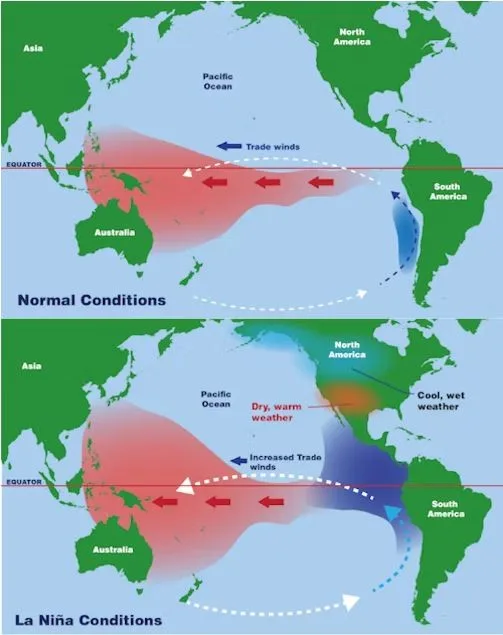
Impacts
- Increased rainfall: Regions such as Southeast Asia, northern Australia, and parts of South America often experience above-average rainfall during La Niña events.
- Drier conditions in some areas: Conversely, regions like the southwestern United States and parts of Africa experience below-average rainfall, leading to drought conditions.
- Stronger Atlantic hurricanes: La Niña tends to reduce wind shear in the Atlantic, creating conditions that are more conducive to the development of hurricanes.
- Cooler temperatures: Some areas experience cooler temperatures than normal, particularly in the Pacific Northwest of the United States and parts of South America.
Konyak Tribe
Syllabus: GS2/ Governance, Tribal Issues
In News
- The Konyak Union, the apex body of the Konyak community in Nagaland, has recently raised concerns regarding a boundary line shown on Google Maps, which they claim inaccurately represents the traditional territory of the Konyak tribe.
About Konyak tribe
- They belong to the Mongoloid race, and they are one of the largest tribes in Nagaland.
- Historically, the Konyak tribe was known for their practice of headhunting, a cultural ritual tied to warfare and honor.
- Before the advent of Christianity, which has since become the dominant religion among the Konyaks, they practiced Animism, a belief system where they worship various elements of nature, including trees, rivers, and animals.
- The Konyaks have a patriarchal society.
BPaLM regimen for Multidrug-Resistant Tuberculosis
Syllabus :GS 2/Health
In News
- The Union Ministry of Health & Family Welfare has approved the introduction of the BPaLM regimen for Multidrug-Resistant Tuberculosis (MDR-TB) .
About BPaLM regimen
- The BPaLM regimen, which consists of a four-drug combination – Bedaquiline, Pretomanid, Linezolid and Moxifloxacin.
- Pretomanid has earlier been approved & licensed for use in India by Central Drugs Standard Control Organization (CDSCO).
- It is a novel treatment for Multidrug-Resistant Tuberculosis (MDR-TB) which was approved under National TB Elimination Program (NTEP) .
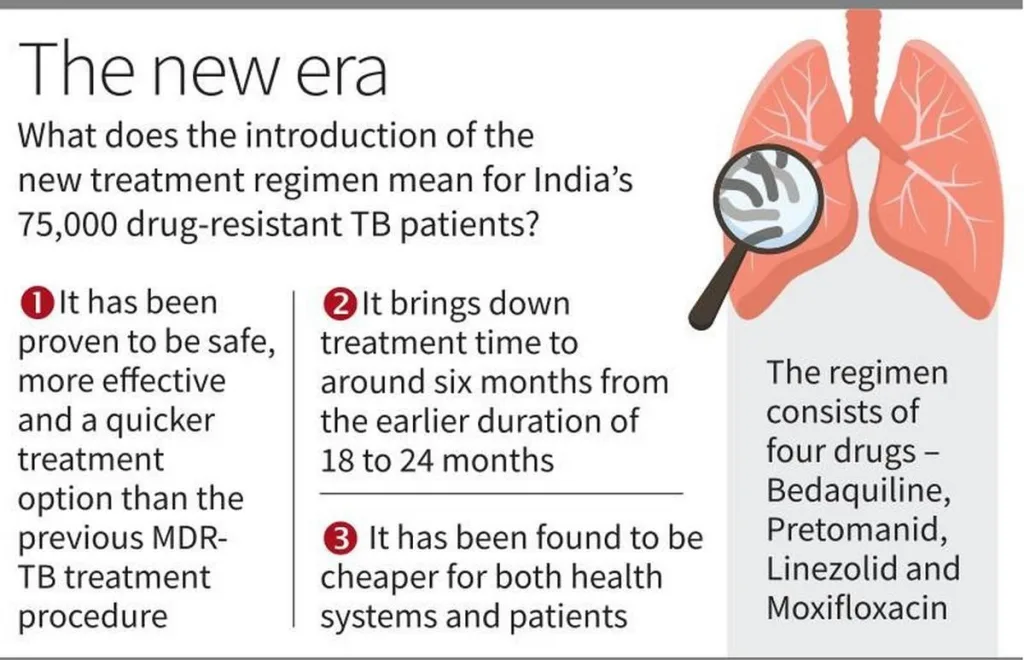
Benefits:
- It reduces treatment duration to six months compared to the traditional 20 months.
- It is proven to be safer and more effective with a high treatment success rate.
- It provides overall savings and reduces the burden on patients.
National Tuberculosis Elimination Program (NTEP):
- It was formerly known as the Revised National Tuberculosis Control Programme (RNTCP), renamed in 2020
- It aims to strategically reduce TB burden and achieve elimination by 2025, five years ahead of the Sustainable Development Goals.
- It emphasizes on detecting all TB cases, including those from private providers and high-risk populations.
Other Related Initiatives:
- Pradhan Mantri TB Mukt Bharat Abhiyaan (PMTBMBA): Launched by the President in 2022, to encourage collective efforts towards TB elimination.
- Ni-kshay Mitra: Provides additional diagnostic, nutritional, and vocational support to TB patients.
- Laboratory Network: India has 7,767 rapid molecular testing facilities and 87 culture & drug susceptibility testing laboratories to support MDR-TB detection and treatment.
FAO Food Price Index (FFPI)
Syllabus: GS3/ Economy
In News
- Recently, the benchmark for world food commodity prices, the FAO Food Price Index (FFPI), showed a marginal decline in August 2024.
About FAO Food Price Index (FFPI)
- The FAO Food Price Index was introduced in 1996 by the Food and Agriculture Organization (FAO) as a public good to monitor developments in global agricultural commodity markets.
- It serves as a barometer for the global food commodity market, tracking price fluctuations of major food items and providing insight into potential food security challenges.
- The index is a measure of the monthly changes in international prices of a basket of food commodities. It consists of the weighted average of five commodity group price indices, with weights based on the average export shares of each group over the period 2014–2016.
- Components of the FFPI: Meat, Dairy Products, Cereals, Vegetable Oils, Sugar etc
VisioNxt
Syllabus :GS 3/Economy
In News
- Union Minister of Textiles launched India’s first fashion forecasting initiative ‘VisioNxt’
About VisioNxt
- It is Funded by the Ministry of Textiles, Government of India under the Research & Development scheme.
- Affiliated with the National Institute of Fashion Technology (NIFT), leveraging its 18 campuses, in-house expertise, and extensive alumni network.
- It is India’s first-ever initiative that combines AI and EI to generate fashion trend insights and forecasts.
- Mission : Its mission is to identify, map, and analyse geo-specific trends, reflecting the positive plurality, cultural diversity, and socio-economic nuances of India while collating comprehensive trends and insights.
- It developed ‘Deep Vision’, an indigenous trend forecasting system combining Artificial Intelligence (AI) and Emotional Intelligence (EI).
- Importance :It reduces dependence on global forecasting agencies, provides unique insights into Indian fashion consumers, integrates India’s strength in information technology with textiles, and combines artificial and human intelligence
- Enhance India’s global presence in the fashion industry by fostering healthy competition and showcasing Indian culture and design
Alzheimer’s Risk Linked To Light Pollution
Syllabus: GS2/ Health
Context
- The researchers have found that Excessive exposure to light pollution at night may raise the risk of developing Alzheimer’s disease.
About
- Light pollution is the human-made alteration of outdoor light levels from those occurring naturally.
- In the research it was found that in people under age 65, light pollution had a stronger correlation to Alzheimer’s disease prevalence than any other risk factor studied.
Alzheimer’s disease
- Alzheimer’s is the most common type of dementia, an umbrella term for a range of conditions that involve the loss of cognitive functioning.
- Cause: It involves the formation of plaques and tangles in the brain, and the accelerated aging of certain neurons concerned with storage and processing of memory.
- Early symptoms include forgetfulness and as the illness progresses, patients become more confused, lose their way around familiar places, and have difficulties with planning and completing simple tasks.
- Prevalence: According to WHO more than 55 million people suffer from dementia worldwide, with Alzheimer’s contributing to around 75% of these cases.
- Anywhere between 3 and 9 million Indians are believed to suffer from the disease, a number that is set to grow as India’s population ages.
MSCI Emerging Markets Investable Market Index (EM IMI)
Syllabus: GS3/ Economy
Context
- India has surpassed China to become the largest weighting in the MSCI Emerging Market Investable Market Index (EM IMI), where India’s weightage was 22.27 percent as compared to 21.58 percent of China.
MSCI Emerging Markets Investable Market Index (EM IMI)
- It is a comprehensive index that includes large, mid, and small-cap stocks from 24 emerging market countries.
- MSCI IMI consists of 3,355 stocks at present and the index broadly represents about 85% of the free float-adjusted market capitalization in each of the included countries.
India’s Strong performance in Equity Markets
- Several key factors have contributed to this favorable trend viz;
- Robust macroeconomic fundamentals of the Indian economy and the impressive performance of Indian corporations,
- 47% rise in foreign direct investment (FDI) during the initial months of 2024,
- Decline in Brent crude prices, and
- Substantial foreign portfolio investment (FPI) in the Indian debt markets.
Saturn’s Majestic Rings
Syllabus :GS 3/Space
Context
- In 2025, Saturn’s iconic rings will briefly “disappear” from view due to an optical illusion caused by the planet’s axial tilt.
An optical illusion
- Saturn, the sixth planet from the Sun in the solar system, is tilted at an angle of 26.73 degrees and takes about 29.4 Earth years to complete a single orbit of the Sun.
- This means that for half of a Saturn year (roughly 15 years), the gas giant is tilted towards the Sun, and for the other half it is tilted away from it.
- Its rings too are tilted at the same angle, and as the planet revolves, they appear to change their orientation when viewed from Earth.
- Every 13 to 15 years, the edge of Saturn’s rings aligns directly with Earth. This is what will happen in March 2025 when only the edges of the ring will be visible from our planet.
- Saturn’s rings are incredibly thin relative to their width, being only about 30 feet thick. They are composed almost entirely of water ice.
Other Planets with Rings
- Jupiter: Has faint rings composed mostly of dust particles.
- Uranus: Possesses a complex ring system made of dark, narrow rings of rocky material.
Exercise VARUNA
Syllabus :GS 3/Defence
Context
- The Indian and French navies held their 22nd edition of bilateral naval exercise ‘VARUNA’ in the Mediterranean Sea.
About
- The bilateral exercise VARUNA, which began in 2001, has evolved significantly over the years and a series of advanced naval operations were conducted during the present edition.
- The conduct of ‘VARUNA’ in the Mediterranean Sea marks a significant milestone in the maritime domain between India and France displaying Indian Navy’s outreach and commitment towards sustained operations far away from the Indian Ocean Region (IOR).
Phrynarachne Decipiens
Syllabus: GS3/ Species in News
In News
- A species of spider, Phrynarachne decipiens, known as the bird-dung crab spider, has been newly discovered in Assam.
About
- Previously found in Malaysia, Java, and Sumatra.
- It is better known as the bird dung or bird-dropping crab spider.
- It is distinguished by its stout spermathecae, a sac-like organ in the female reproductive tract that stores sperm after copulation. In this species, the posterior heads of the spermathecae are almost touching, a key identifying feature.
